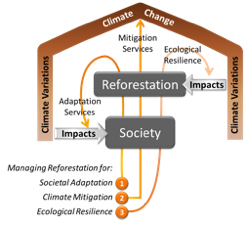In the Fight Against Climate Change, Reforestation Can do More than We Think
Locatelli, B., C. P. Catterall, P. Imbach, C. Kumar, R. Lasco, E. Marín-Spiotta, B. Mercer, J. S. Powers, N. Schwartz, and M. Uriarte. 2015. Tropical reforestation and climate change: beyond carbon. Restoration Ecology 23:337-343. http://doi.org/10.1111/rec.12209
A few years ago, I was walking in Costa Rica below the tall trees of a wood production plantation. Looking at the impressive trunks, I was thinking of all the wood and all the carbon that they contained, carbon that used to be in the atmosphere contributing to climate change.
Planting trees for reducing atmospheric carbon is often seen as a good option for mitigating climate change. Is it always good? Not always, but it can be better if we could see the broad picture and avoid looking at carbon only.
After some time walking in the plantation, I crossed a wooden bridge where two small streams met. One stream was flowing from the plantation and was almost dry, while the other one came from a natural forest and had plenty of water.
This example illustrates the trade-offs of reforestation decisions, including tree planting: a forest plantation may contribute to mitigate climate change but, if it is not well designed, it may create new problems for water or biodiversity, which are both important for adaptation to climate change. If the fast-growing plantation consumes too much water, what will be left to communities downstream, especially when they already face drought problems? Does it make sense to try to contribute to one climate change solution (mitigation) while impeding progress on the other solution (adaptation)?
These trade-offs motivated this interdisciplinary group of authors, to synthesize what we know about the contributions of reforestation to the fight against climate change. We found that reforestation initiatives can do better to ensure that communities and ecosystems are more resilient to climate change. And it has a lot to do with the planning. This paper shows how planning for “climate-smart reforestation” needs to incorporate measures for reducing the direct and indirect impacts of climate change and variability on reforestation. We are not quite there yet. Achievement of climate-smart reforestation is currently limited by a range of uncertainties and knowledge gaps. Improved knowledge will help managers make informed decisions adapted to local social and environmental conditions.
 Figure 1. Conceptual framework of climate-smart reforestation: reforestation management contributes to the adaptation of society to climate variations (1) and climate change mitigation (2), while ensuring that reforestation is resilient to the direct and indirect impacts of climate variations (3).
Figure 1. Conceptual framework of climate-smart reforestation: reforestation management contributes to the adaptation of society to climate variations (1) and climate change mitigation (2), while ensuring that reforestation is resilient to the direct and indirect impacts of climate variations (3).
The PARTNERS connection
This paper originated at the first PARTNERS workshop in 2014, where our group gathered to discuss the interactions between reforestation and climate change. We published a paper in 2015 from those exchanges. The paper has since been often cited by different types of information sources and publications (see https://wiley.altmetric.com/details/3908987/).
See also:
Smart reforestation must go beyond carbon
Es tiempo de pensar en mitigación y adaptación conjunta


